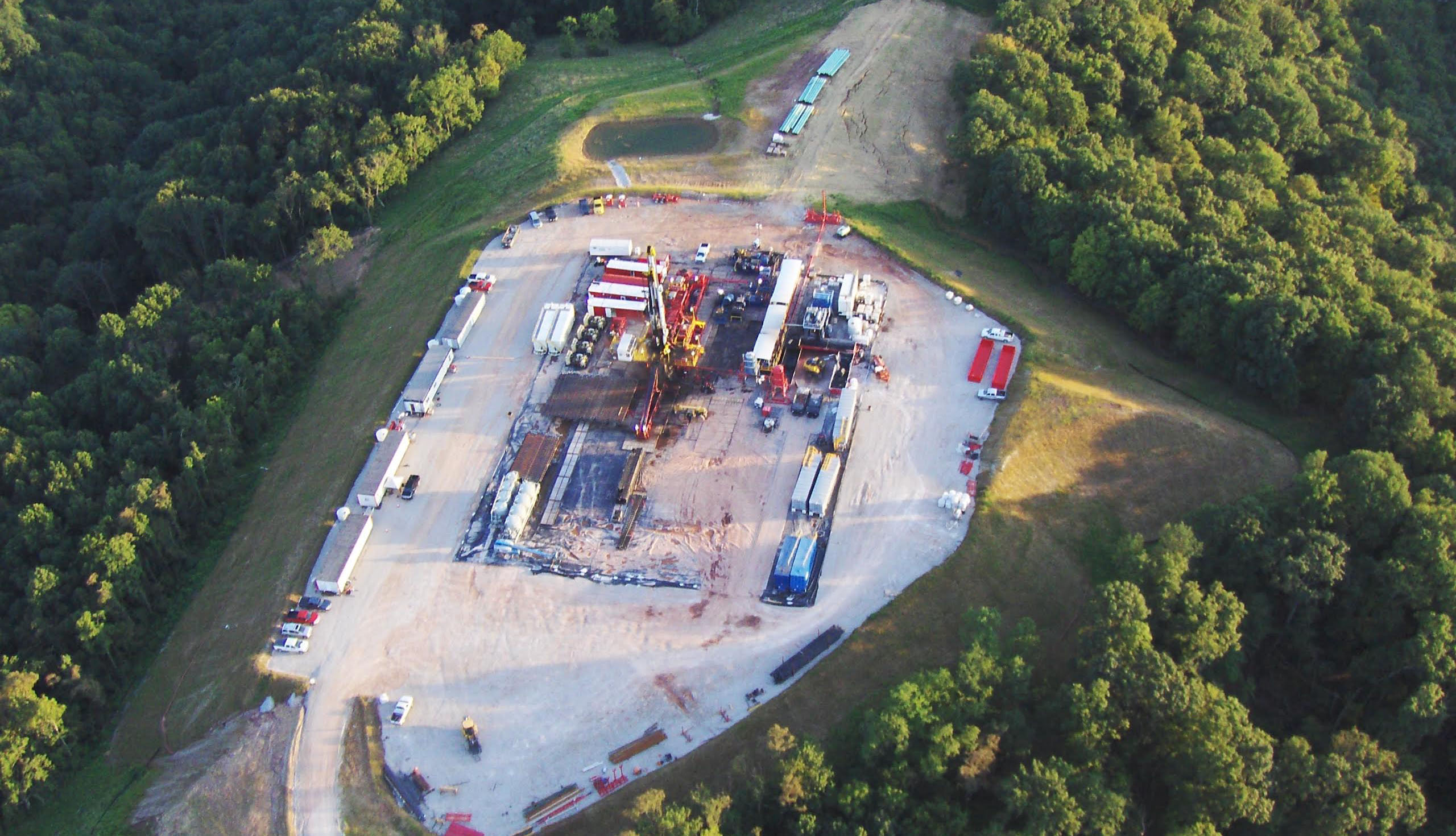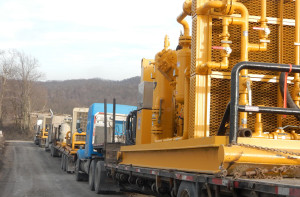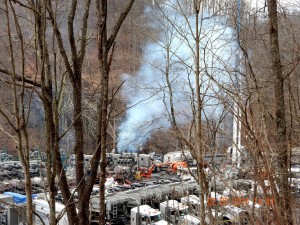My old Kentucky home meets fracking
By Campbell Wood
Photos by Bill Hughes
Close to 400 people attended a public meeting on the night of January 27th at the Russell Acton Folk Center in Berea to learn about hydraulic fracturing, or fracking, as it’s better known. About 100 people were turned away at the door because of fire-code regulations. Inside, chairs filled, people stood along the walls. Kentucky Environmental Foundation (KEF), Sierra Club, Kentuckians for the Commonwealth (KFTC), Kentucky Heartwood and Kentucky Resources Council (KRC) organized the meeting, which featured two main speakers: Bill Hughes of Wentzel County, West Virginia, where fracking has become part of the landscape, and Tom Fitzgerald, environmental lawyer and founder of KRC.
As things got underway, Janice Owens of Clear Creek, Kentucky, spoke as a member of the community. “Not only our water source, where we live and our way of life would be affected by this,” she said. “We also are artists and craftsmen – it would affect our livelihood, our ability to make a living, just by tourism being disturbed in this city. The business of tourism is important here. You’re talking thousands of jobs. Berea is crafts capital of Kentucky. With trucks constantly coming and going, tourism would be dead.”
“I think of Denton, Texas,” Owens continued. “Denton is where fracking was born. 210 wells. They have first hand experience. And by popular vote they voted to ban fracking. So if Denton, Texas, doesn’t want fracking … neither do we.”
Denton caught national attention when this city in the heart of northern Texas oil and gas fields banned fracking in November of 2014. Denton is in the region around Fort Worth where George Mitchell, the late petroleum engineer and natural gas baron, developed the now controversial method of deep drilling. Thousands of feet below the surface the drilling makes a 90-degree turn to drill horizontally into the shale layer. Detonations shatter the shale. Then a mixture of water, sand and chemicals shoot into the shale to release the gas and oil embedded there.
According to Food and Water Watch (foodandwaterwatch.org), an organization that tracks anti-fracking measures, there are currently 463 such measures on state and local levels across the country. Those measures include enacted or proposed bans and moratoriums and resolutions, some addressing the entire process of fracking, and some, parts of the process.
Fracking in West Virginia (the land of country roads and mountain mommas)
“We have an advantage here that the folks in West Virginia, Pennsylvania or Ohio didn’t have,” said Jim Scheff of Kentucky Heartwood, in his introduction for Bill Hughes. “We can look at these other states and see what’s happened. For many years the industry said that a lot of things people have said about getting sick, wells collapsing and getting polluted, truck wrecks, spills and explosions – we were told again and again it’s just not true. The last year and a half the science has caught up. We’re finding that what people said they were suffering through was real. They weren’t making it up. It’s happening.”
When Bill Hughes stepped forward to address the gathering, he said he wished they’d had someone ten years ago come tell them about what living with fracking was like. “We got totally blindsided,” he said.
Narrating while photographic images appeared on a large screen, Hughes described impacts of fracking on his rural county.
First is the heavy increase in traffic, mainly diesel trucks. Acres of land are leveled for each well site. Limestone is hauled in to cover the ground. Well drilling rigs are set up. Pipelines appear “all over the place,” he said, serving the well site to the gas processing plants and compressor stations. He said it was a common sight to see trucks that had run off the sides of roads – trucks that haul tons of sand, water, brine, diesel fuel, and the chemicals that go into the fracking fluid. Spills occur. Road accidents increase. Images of trucks lined up in jams on country roads and of overturned trucks appeared. One tanker truck making its way up a steep icy road, he noted, was filled with hydrochloric acid. “Our first responders have a real problem with it,” Hughes said, regarding spills from toppled trucks. “They want to know what’s in them when one turns over.” Most trucks aren’t marked as to contents.
Hughes said the operations release fumes with hazardous air pollutants (HAPs), and well operators have blanket permits to burn waste. He’s concerned about the long term cumulative effect on the region’s air quality.
Leakage from well pads wash into creeks, he said. Hughes said that the leakage through the concrete casing of the well pads is less a problem then surface spills, impoundment leaks, and pipe breaks. Some spills go unreported. Occasionally polluted residential waters around drilling sites require the homes to have water buffalos, large water tanks for potable water.
In 2011 a Congressional report revealed that there are 750 chemicals and compounds used variably in proprietary fracking mixes that also include unidentified chemicals and compounds that are trade secrets. The list of identified ingredients includes kerosene, benzene, toluene, xylene, formaldehyde and methanol, to name a few. The report states: “Between 2005 and 2009, the oil and gas service companies used hydraulic fracturing products containing 29 chemicals that are known or possible human carcinogens, regulated under the Safe Drinking Water Act (SDWA) for their risks to human health, or listed as hazardous air pollutants under the Clean Air Act.” There is “flowback” to the well head of those fracking mixtures that sometimes leak. But even worse, says Hughes, is the “produced” water.
Produced water has absorbed fluids that have been in the geologic formations for a couple million years,” said Hughes. “It has absorbed all of the heavy metals and radioactive isotopes, primarily radium 226.” All of this brings into question the reasoning behind Congress, in 2005, exempting fracking from the Safe Water Drinking Act.
West Virginia now has tens of thousands of abandoned well sites,” Hughes said, “and there’s a poor track record of making the original driller responsible for plugging the well and guaranteeing safety.”
Regulatory politics, and it’s in the details
Tom Fitzgerald talked about regulations before talking about the leases that “landmen” (oil and gas company representatives) bring to people’s doorsteps. He noted that there isn’t an “overarching federal law over oil and gas exploration, production and transmission like there is over the coal industry.
Fitzgerald explained that Kentucky is part of the interstate Oil and Gas Compact Commission, which was founded to conserve the resource to maximize its effective production. In this context “clean water is considered a pollutant,” said Fitzgerald. “Water can flood a well and ruin production. The regulatory concern here is not with safeguarding water, the environment or people’s property rights, but with boosting production.
“The question is not whether the oil and gas laws and regulations that have been developed over the years are sufficient for classic primary production from low pressure wells in a shallow formation,” said Fitzgerald. “The question is if they are adequate in this day and age to address the prodigy of the marriage of hydraulic fracturing and horizontal drilling. They’re not.”
He told the story of Carol Smith, Judge Executive of Letcher County, who in 2003 recognized the absence of adequate regulations to protect public infrastructure and private property rights from damaging effects of oil and gas operations. Fitzgerald said that Smith proposed that counties have the authority to regulate aspects of the oil and gas operations, since the state wasn’t doing an adequate job. The oil and gas industry went to Frankfort and preempted local government, said Fitzgerald, so that outside of zoning, local government could have nothing to do with oil/gas production, transmission or exploration.
“The state environmental agency, now the Environmental Energy Cabinet,” said Fitzgerald, “was supposed to do a comprehensive regulation to protect the interests of landowners and water resources in the environment. Twelve years after the fact, that still has not been done. And there are a number of reasons why.”
“I am here to report,” he continued, “that there has been a work group in place now for about a year that has been looking at the unique challenges brought by deep well drilling and horizontal drilling, with high volume, high pressure hydro-fracking.” He said that he expected a consensus bill with some improvements to regulations would be passed soon.
Fitzgerald said that property owners should be aware that the company leases presented are not designed to serve the property owner’s rights and protections. “They are designed to be as broad as possible, require as little as possible (from the oil and gas company) and shed as many responsibilities as possible to maximize company profits.” He added that the aim is to privatize the profits and socialize the problems.
Craig Williams of KEF spoke up. “I got a call from the Attorney General’s office today,” he said. If any of your neighbors have signed these leases and are having second thoughts, if they believe the lease was presented to them in any misrepresentation or fraudulent manner, the Attorney General’s office is very interested in hearing from you. And it is easier than you might think to get one of these leases taken back.”
Since that meeting both houses of the Kentucky General Assembly passed what the Herald-Leader called “modest protections for the environment and neighboring landowners.” In that editorial, March 1, the Herald-Leader pointed out two glaring needs still unaddressed. One, “to allow greater public participation, by both individual citizens and local governments.” The other, to study seismic conditions before permitting drilling, as increased earthquake activity has been linked to fracking operations and Kentucky has fault lines with a history of earthquakes.
Thanks to film maker Ben Evans (BenEvansCreative.com) for making available his film of the meeting in Berea.














